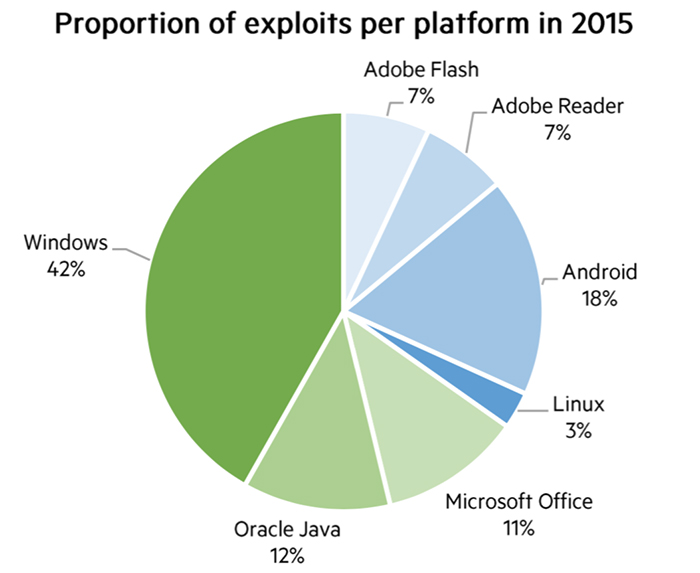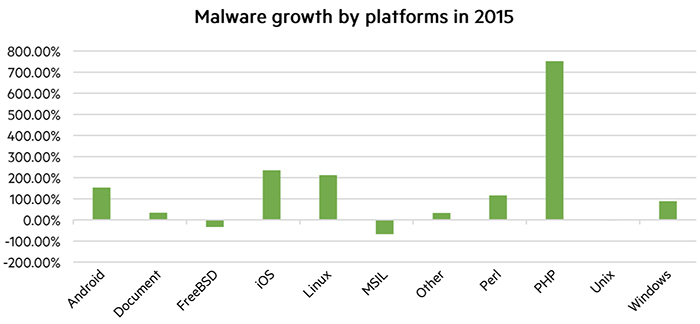Fighting malware monetization and application vulnerabilities
As the traditional network perimeter disappears and attack surfaces grow, security professionals are challenged with protecting users, applications and data – without stifling innovation or delaying enterprise timelines.
Hewlett Packard Enterprise identified the top security threats plaguing enterprises over the past year: malware monetization and application vulnerabilities. This year’s Cyber Risk Report examines the 2015 threat landscape in this context, and highlights important industry issues such as new security research regulations, the “collateral damage” from high profile data breaches, shifting political agendas, and the ongoing debate over privacy and security.

“In 2015, we saw attackers infiltrate networks at an alarming rate, leading to some of the largest data breaches to date, but now is not the time to take the foot off the gas and put the enterprise on lockdown,” said Sue Barsamian, senior vice president and general manager, HPE Security Products, Hewlett Packard Enterprise. “We must learn from these incidents, understand and monitor the risk environment, and build security into the fabric of the organization to better mitigate known and unknown threats, which will enable companies to fearlessly innovate and accelerate business growth.”
Applications are the new battlefield
While web applications pose significant risk to enterprises, mobile applications present growing and distinctive risks.
- Mobile applications’ frequent use of personally identifiable information presents significant vulnerabilities in the storage and transmission of private and sensitive information.
- Approximately 75 percent of the mobile applications scanned exhibited at least one critical or high-severity security vulnerability, compared to 35 percent of non-mobile applications.
- Vulnerabilities due to API abuse are much more common in mobile applications than web applications, while error handling – the anticipation, detection, and resolution of errors – is more often found in web applications.

Malware monetization
Malware has evolved from being simply disruptive to a revenue-generating activity for attackers. While the overall number of newly discovered malware samples declined 3.6 percent year-over-year, the attack targets shifted notably in line with evolving enterprise trends and focused heavily on monetization.
- As the number of connected mobile devices expands, malware is diversifying to target the most popular mobile operating platforms. The number of Android threats, malware, and potentially unwanted applications have grown to more than 10,000 new threats discovered daily, reaching a total year-over-year increase of 153 percent. Apple iOS represented the greatest growth rate, with a malware sample increase of more than 230 percent.
- Malware attacks on ATMs use hardware, software loaded onto the ATM, or a combination of both to steal credit card information. In some cases, attacks at the software level bypass card authentication to directly dispense cash.
- Banking Trojans, such as variants of the Zbot Trojan, continue to be problematic despite protection efforts. More than 100,000 of these were detected in 2015 as cybercriminals increase their malware monetization efforts
- Ransomware is an increasingly successful attack model, with several ransomware families wreaking havoc in 2015 by encrypting files of consumer and corporate users alike. Examples include: Cryptolocker, Cryptowall, CoinVault, BitCryptor, TorrentLocker, TeslaCrypt, and others.
Patch or perish
Software vulnerability exploitation continues to be a primary vector for attack, with mobile exploits gaining traction.
- Similar to 2014, the top ten vulnerabilities exploited in 2015 were more than one year old, with 68 percent being three years old or more.
- In 2015, Microsoft Windows represented the most targeted software platform, with 42 percent of the top 20 discovered exploits directed at Microsoft platforms and applications.
- 29 percent of all successful exploits in 2015 continued to use a 2010 Stuxnet infection vector that has been patched twice.
Actionable intelligence and recommendations
Apps are the new battlefield: The network perimeter is vanishing; attackers have shifted focus to target applications directly. Security professionals must adjust their approach accordingly, defending not just the edge but the interactions between users, applications and data regardless of location or device.
Patch or perish: 2015 was a record year for the number of security vulnerabilities reported and patches issued, but patching does little good if end users don’t install them for fear of unintended consequences.4 Security teams must be more vigilant about applying patches at both the enterprise and individual user level. Software vendors must be more transparent about the implications of their patches so that end-users aren’t afraid to deploy them.
Monetization of malware: Ransomware attacks targeting the enterprise and individuals are on the rise, requiring both increased awareness and preparation on the part of security professionals to avoid the loss of sensitive data. The best protection against ransomware is a sound backup policy for all important files on the system.
Prepare for shifting politics: Cross-border agreements pose challenges for enterprises struggling to keep their systems secure and in compliance. Organizations must follow the changing legislative activity closely and maintain a flexible security approach.
For those of you interested in security research, Sue Barsamian provides an overview of the threat landscape and a behind the scenes discussion with three of the security researchers.